Publication
Article
Oncology Live®
Novel Drug Sparks Hope for Targeting HER3 in NSCLC and Beyond
Author(s):
Patritumab deruxtecan, a novel antibody-drug conjugate, is emerging as a promising HER3-directed therapy in patients with non–small cell lung cancer and perhaps other solid malignancies.
Paul A. Bunn Jr, MD
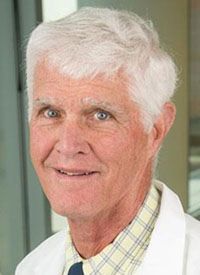
Although oncogenic activation of the HER3 receptor has been identified as a significant source of drug resistance and treatment failure, efforts to develop therapies targeting this mechanism have so far fallen short.1 Now, patritumab deruxtecan, a novel antibody-drug conjugate (ADC), is emerging as a promising HER3-directed therapy in patients with non–small cell lung cancer (NSCLC) and perhaps other solid malignancies.
Patritumab deruxtecan monotherapy resulted in a 39% objective response rate (ORR) in patients with EGFR-mutated adenocarcinoma previously treated with anti-EGFR tyrosine kinase inhibitor (TKI) therapy and platinum-based chemotherapy, according to interim data from the phase 1 U31402-A-U102 study (NCT03260491) presented at the 2021 American Society of Clinical Oncology (ASCO) Annual Meeting. The median progression-free survival (PFS) was 8.2 months.2
Those findings impressed lung cancer experts who participated in “Molecular Targets on the Horizon in Non–Small Cell Lung Cancer OncLive® Scientific Interchange & Workshop,” a panel discussion held on July 15.
“The median progression-free survival and response rate in the fourth line are far exceeding anything else we’ve seen before” in this setting, noted program moderator Paul A. Bunn Jr, MD, a 2014 Giants of Cancer Care® award winner in the lung cancer category. Bunn is the James Dudley Chair in Cancer Research and a distinguished professor of medicine–medical oncology at the University of Colorado School of Medicine in Aurora.
Patients who participated in the study had a median of 4 prior lines of systemic therapy (range, 1-9), with 86% having received osimertinib (Tagrisso), a third-generation EGFR TKI that is the preferred first-line option for patients with EGFR-mutated NSCLC.2,3
“I think the largest clinical need that we’re thinking about addressing right now in the context of the treatment paradigm in the United States is patients who’ve received prior osimertinib,” said panel member Christine M. Lovly, MD, PhD, who detailed the 2021 ASCO findings during the program.
Patritumab deruxtecan, also known as HER3-DXd and U3-1402, “is a very exciting drug” that generated responses in heavily pretreated patients regardless of HER3 protein expression and genomic resistance alterations, said Lovly, an associate professor of medicine and the Ingram Associate Professor of Cancer Research at Vanderbilt University in Nashville, Tennessee.
“I’m really looking forward to future development of this drug as a potential mechanism to fill this unmet need of how we treat patients who develop acquired resistance to osimertinib therapy,” Lovly said. “[Investigators are] trying to fill this niche of how we treat EGFR TKI resistance across multiple potential genomic biomarkers of resistance. And I think they’ve hit the mark so far.”
The ongoing clinical development program for patritumab deruxtecan in EGFR-mutated NSCLC includes the phase 2 HERTHENA-Lung01 study (NCT04619004), which is comparing fixed and up-titration dosing schedules, and a phase 1 study (NCT04676477) that is evaluating the ADC in combination with osimertinib in patients with recurrent and treatment-naïve disease. Patritumab deruxtecan also is being studied in colorectal and breast cancers (Table).
Table. Ongoing Clinical Studies of Patritumab Deruxtecan
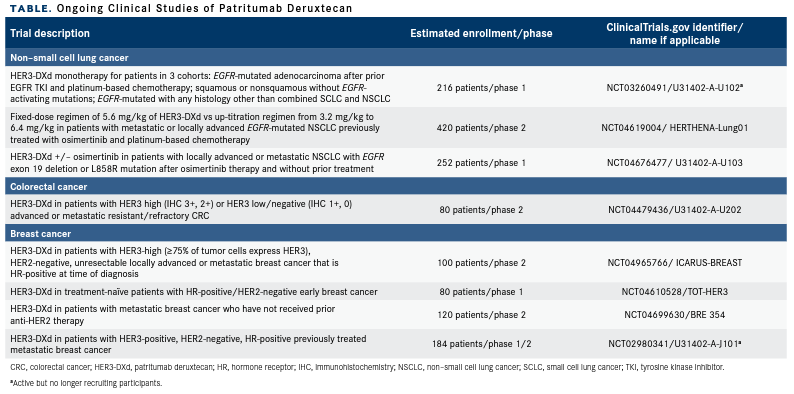
In the broader context of anticancer research, Lovly said that much remains to be learned about HER activity. “We have studied the ERBB or HER family of receptors in human tumors for many, many years now, but I would say we are far from exhausting the therapeutic opportunities offered by inhibiting these receptors, either as a single receptor or in receptor pairs,” Lovly said.
HER3’S Role in Cancer
HER3 is one of 4 receptor tyrosine kinases (RTKs) that make up the HER family. Found predominantly on the surface of epithelial, mesenchymal, and neuronal cells, these receptors are key players in the transduction of intracellular signals that regulate normal cell growth and differentiation via binding of a wide range of different ligands.4-6
Discovered 30 years ago, HER3 is unique among HER family members because it is a pseudokinase.1 Normally upon ligand binding, RTKs pair up with either another receptor molecule of the same type (homodimerization) or a different kind of RTK (heterodimerization). This causes a conformational change in the second receptor molecule and triggers its tyrosine kinase activity. Because it has limited kinase activity, HER3 cannot signal through homodimers; its activity therefore relies on the formation of heterodimers with other members of the HER family, predominantly HER2.4-6
HER3 is activated by 2 ligands, HRG1 and HRG2, both members of the heregulin protein family (also referred to as neuregulins NRG1 and 2, respectively). Following ligand binding and heterodimerization, HER3’s kinase partner is activated and phosphorylates tyrosines within the intracellular domain of HER3.7,8 These phosphorylated tyrosines form a binding platform for a host of key proteins that subsequently trigger downstream signaling cascades, including in the PI3K/AKT, MAPK, and JAK/STAT pathways.4-6 Preclinical studies also have shown that HER3 promotes drug resistance by upregulating HER3 in cancer cells resistant to EGFR TKIs.9 (Figure 19)
Figure 1. HER3-mediated Resistance to EGFR Inhibition9
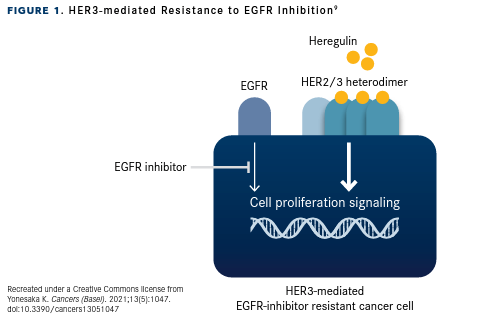
HER3 overexpression has been noted in many types of cancer, including breast, gastric, colorectal, bladder, prostate, and ovarian, as well as NSCLC, head and neck squamous cell carcinoma, and melanoma.5,6
However, the precise function of HER3 overexpression across these tumor types is not entirely clear; questions remain regarding whether and exactly how it might operate as a driver of cancer. The most solid evidence has been observed in breast and lung cancers, in which the tumor-promoting role of HER3 overexpression has been shown to be predominantly in its capacity as a partner for HER2 and EGFR, respectively.4-6,10
In NSCLC, HER3 overexpression in primary tumors has been significantly associated with metastatic progression (P = .006) and decreased relapse-free survival time (P = .013). Investigators detected HER3 expression via immunohistochemistry (IHC) analysis in 82.7% of 148 NSCLC samples, with intensity levels classified as negative, intermediate, or strong. The prevalence of strong HER3 expression was 9.1% in primary tumors vs 35.3% in brain metastases.11
The Making of an ADC
Despite the rationale for HER3 inhibition, more than a decade of research has not yet produced an FDA-approved drug with this mechanism. Because HER3 has limited intrinsic kinase activity, small-molecule kinase inhibitors are unlikely to be useful, leading investigators to explore development of HER3-targeted monoclonal antibodies (mAbs). However, most HER3 mAbs evaluated in clinical studies demonstrated limited activity, so the focus has shifted to novel designs such as ADCs (Figure 29).1,9
Figure 2. Components of an Antibody-Drug Conjugate9
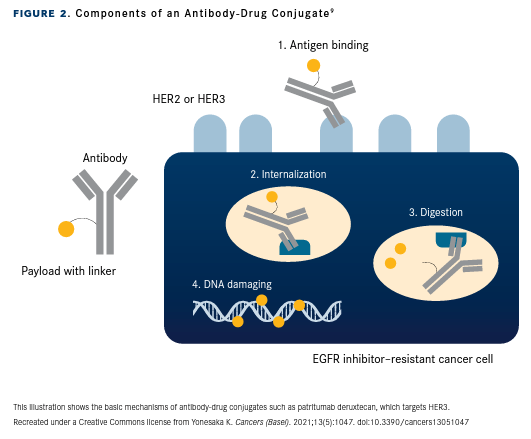
The development arc of patritumab deruxtecan illustrates this trend. Daiichi Sankyo Company, Limited initially sought to develop patritumab (U3-1287), a fully human anti-HER3 mAb that forms the antibody component of the ADC.
As a naked mAb, patritumab demonstrated disease stabilization as the best response in a first-in-human phase 1 study (NCT00730470) in 57 patients with advanced solid tumors, including 20 participants with NSCLC. Overall, 24.6% of participants had stable disease and 40.4% had progressive disease.12 In breast cancer, the combination of patritumab plus trastuzumab (Herceptin), an anti-HER2 mAb, resulted in an ORR of 38.9% (95% CI, 20.3%-61.4%), including 2 complete responses (CRs), and a median PFS of 274 days among 18 patients with HER2-overexpressing metastatic disease, according to findings from a phase 1b study (JapicCTI-121772) conducted in Japan.13
Patritumab advanced to phase 3 testing in combination with erlotinib (Tarceva) in patients with previously treated locally advanced or metastatic EGFR wild-type NSCLC in the HER3-Lung study (NCT02134015). However, Daiichi Sankyo halted the study in May 2016 after the combination failed to meet the efficacy criteria of superior PFS in participants with high heregulin expression.14 The median PFS was 1.9 months (80% CI, 1.4-3.0) in 47 patients treated with the patritumab-erlotinib combination vs 2.7 months (80% CI, 1.7-2.9) in 48 patients who took erlotinib plus placebo.15
Scientists in Japan subsequently engineered patritumab deruxtecan by joining the mAb with a topoisomerase I inhibitor payload (deruxtecan) via a tetrapeptide-based cleavable linker. In preclinical studies, the novel agent showed promising antitumor activity in mouse models, including patient-derived xenografts, and a tolerable safety profile in tests conducted in rats and monkeys.16
The experiments showed that the ADC inhibited HER3-activated signaling similar to the naked antibody patritumab while the deruxtecan released into HER3-expressing cells promoted cytotoxic activity through DNA damage and apoptosis induction. The investigators concluded that the activity of the drug was “driven by HER3-mediated payload delivery via high internalization into tumor cells.”16
Moreover, the design uses the same linker-payload technology that Daiichi Sankyo developed for fam-trastuzumab deruxtecan-nxki (Enhertu), a HER2-directed ADC.16 The FDA has approved the drug for the treatment of patients with unresectable or metastatic HER2-positive breast cancer who have received 2 or more prior anti–HER2-based regimens in the metastatic setting and for patients with locally advanced or metastatic HER2-positive gastric or gastroesophageal junction adenocarcinoma previously treated with a trastuzumab- based regimen.17
Promising NSCLC Findings
In targeting HER3 in NSCLC, investigators are seeking to improve upon current treatment options for patients with disease progression on prior EGFR TKI therapy. Platinum-based chemotherapy for these patients yields a PFS ranging from 2.7 to 6.4 months, and salvage therapies have shown a PFS of 2.8 to 3.2 months, Pasi A. Jänne, MD, PhD, said in presenting the patritumab deruxtecan findings at 2021 ASCO.2
Moreover, there is a wide variation of genomic alterations associated with EGFR TKI resistance, with differing genomic profiles after first-line therapy with erlotinib, gefitinib (Iressa), or afatinib (Gilotrif), second-line therapy with osimertinib, and first-line treatment with osimertinib.
“The resistance mechanisms are diverse. They include on-target mechanism resistance, as well as bypass alterations. And importantly, in many patients, especially those treated with first-line osimertinib, no identifiable resistance mechanism is often found,” said Jänne, director of the Lowe Center for Thoracic Oncology, the Belfer Center for Applied Cancer Science, and the Chen-Huang Center for EGFR Mutant Lung Cancers at Dana-Farber Cancer Institute in Boston, Massachusetts.
In U31402-A-U102, Jänne and colleagues established a recommended dose for patritumab deruxtecan of 5.6 mg/kg every 3 weeks in 21-day cycles during the study’s dose-escalation phase. In the dose-expansion phase, the agent is being evaluated in 3 cohorts of patients: (1) EGFR-mutant adenocarcinoma with prior EGFR TKI therapy and platinum-based chemotherapy; (2) squamous or nonsquamous NSCLC without EGFRactivating mutations; and (3) EGFR-mutated NSCLC of any histology other than combined small cell lung cancer and NSCLC.
After a median follow-up of 10.2 months (range, 5.2-19.9), the ORR was 39% (95% CI, 26%-52%), including 1 CR among 57 patients who received the recommended dose in cohort 1 and in the dose-escalation phase. The median PFS was 8.2 months (95% CI, 4.3-8.3), the median time to response was 2.6 months (range, 1.2-5.4), and the median duration of response (DOR) was 6.9 months (95% CI, 3.1-not evaluable [NE]).2
In a subgroup of 44 patients in the same cohort who received prior osimertinib and platinum-based chemotherapy at the recom-mended dose, the findings were similar: an ORR of 39% (95% CI, 24%-55%), including 1 CR; a median PFS of 8.2 months (95% CI, 4.0-NE); a median time to response of 2.7 months (range, 1.2-5.4); and a median DOR of 7.0 months (95% CI, 4.0-NE).
Of note, patritumab deruxtecan generated antitumor responses in patients with varied mechanisms of EGFR TKI resistance such as EGFR-activating mutations and amplification, as well as mutations and fusions involving other genes. Moreover, responses were reported across a wide range of baseline HER3 H-scores, an IHC analysis of membrane HER3 expression in pretreatment biopsy tissue. HER3 was expressed in all evaluable patients, for whom the median H-score was 180 (range, 2-280).
In a safety analysis of patritumab deruxtecan therapy among 81 patients treated across all dosing levels, the incidence of treatment-emergent adverse events (TEAEs) of grade 3 or greater severity was 64%, with the most prevalent TEAEs including a decrease in platelet and neutrophil counts, fatigue, and anemia. There were 4 cases (5%) of interstitial lung disease, none of which were grade 4 or 5 severity. Overall, 7 patients (9%) discontinued treatment due to TEAEs, which included 2 cases of fatigue and 1 each of nausea, decreased appetite, interstitial lung disease, decreased neutrophil count, pneumonitis, and upper respiratory tract infection.2
Need to Refine Biomarkers
During the program, panel members said they were intrigued by the responses seen in patients with low levels of HER3 protein expression.
“Does this reflect on the design of the ADCs, meaning if there are more payloads that are delivered per molecule, could that help promote more of these patients to respond, even with low levels of targets?” Erin Schenk, MD, PhD, an assistant professor of medicine at the University of Colorado School of Medicine in Aurora, asked.
“That’s a great question,” Lovly responded, adding she was not certain of the answer. “We tend to focus on the target of the anti-body but also need to think about how the linker is cleaved in the tumor microenvironment and into the tumor cell. We need to think about the totality of these molecules, not just what they’re targeting on the tumor cell itself, but how that target on the tumor cell is then going to be downregulated and trafficked through the cell; how the linker is going to be cleaved within the tumor, because you can imagine a scenario if you don’t get the cleavage, you’re not going to deliver the payload; and then how different tumors metabolize the payload in different ways.”
Ferdinandos Skoulidis, MD, PhD, MRCP, wondered about using the H-score, which factors in intensity of staining and the percentage of positive cells, to assess HER3 expression. The biomarker could be refined if the extent or uniformity of HER3 staining was assessed, suggested Skoulidis, an assistant professor at The University of Texas MD Anderson Cancer Center in Houston.
“We really need something a little bit more sophisticated than immunohistochemistry to look at the biomarker itself and then really need to think about the receptor coupling and how that’s playing into response as well,” Lovly agreed, noting EGFR and HER3 receptor coupling as an example.
“We really need a lot of rigorous correl-ative science and preclinical studies to understand how exactly these drugs are working,” she added. “We’re so used to think-ing about small molecules now in terms of actionable biomarkers and predicting how the small molecules work. I think we need to reshape our paradigms for studying antibodies in terms of oncogenic signaling and how we’re going to understand resistance, and importantly, how we’re really going to under-stand efficacy.”
Jane de Lartigue, PhD, a freelance medical writer, contributed information to this article.
References
- Haikala HM, Jänne PA. Thirty years of HER3: from basic biology to therapeutic interventions. Clin Cancer Res. 2021;27(13):3528-3539. doi:10.1158/1078-0432.CCR-20-4465
- Jänne PA, Baik CS, Su WC, et al. Efficacy and safety of patritumab deruxtecan (HER3-DXd) in EGFR inhibitor-resistant, EGFR-mutated (EGFRm) non-small cell lung cancer (NSCLC). J Clin Oncol. 2021;39(suppl 15):9007. doi:10.1200/JCO.2021.39.15_suppl.9007
- NCCN. Clinical Practice Guidelines in Oncology. Non-small cell lung cancer, version 5.2021. Accessed August 26, 2021. https://www.nccn.org/professionals/physician_gls/pdf/nscl.pdf
- Jacob W, James I, Hasmann M, Weisser M. Clinical development of HER3-targeting monoclonal antibodies: perils and progress. Cancer Treat Rev. 2018;68:111-123. doi:10.1016/j.ctrv.2018.06.011
- Liu X, Liu S, Lyu H, Riker AI, Zhang Y, Liu B. Development of effective therapeutics targeting HER3 for cancer treatment. Biol Proced Online. 2019;21:5. doi:10.1186/s12575-019-0093-1
- Lyu H, Han A, Polsdofer E, Liu S, Liu B. Understanding the biology of HER3 receptor as a therapeutic target in human cancer. Acta Pharm Sin B. 2018;8(4):503-510. doi:10.1016/j.apsb.2018.05.010
- Breuleux M. Role of heregulin in human cancer. Cell Mol Life Sci. 2007;64(18):2358-2377. doi:10.1007/s00018-007-7120-0
- Fernandez-Cuesta L, Thomas RK. Molecular pathways: targeting NRG1 fusions in lung cancer. Clin Cancer Res. 2015;21(9):1989-1994. doi:10.1158/1078-0432.Ccr-14-0854
- Yonesaka K. HER2-/HER3-targeting antibody-drug conjugates for treating lung and colorectal cancers resistant to EGFR Inhibitors. Cancers (Basel). 2021;13(5):1047. doi:10.3390/cancers13051047
- Campbell MR, Amin D, Moasser MM. HER3 comes of age: new insights into its functions and role in signaling, tumor biology, and cancer therapy. Clin Cancer Res. 2010;16(5):1373-1383. doi:10.1158/1078-0432.Ccr-09-1218
- Scharpenseel H, Hanssen A, Loges S, et al. EGFR and HER3 expression in circulating tumor cells and tumor tissue from non-small cell lung cancer patients. Sci Rep. 2019;9(1):7406. doi:10.1038/s41598-019-43678-6
- LoRusso P, Jänne PA, Oliveira M, et al. Phase I study of U3-1287, a fully human anti-HER3 monoclonal antibody, in patients with advanced solid tumors. Clin Cancer Res. 2013;19(11):3078-87. doi:10.1158/1078-0432.CCR-12-3051
- Mukai H, Saeki T, Aogi K, et al. Patritumab plus trastuzumab and paclitaxel in human epidermal growth factor receptor 2-overexpressing metastatic breast cancer. Cancer Sci. 2016;107(10):1465-1470. doi:10.1111/cas.13017
- Daiichi Sankyo provides update on HER3-Lung study of patritumab in non-small cell lung cancer (NSCLC). News release. Daiichi Sankyo Company Limited. May 31, 2016. Accessed August 30, 2021. https://prn.to/3mOZFSN
- Paz-Arez L, Serwatowski P, Szczęsna A, et al. Patritumab plus erlotinib in EGFR wild-type advanced non–small cell lung cancer (NSCLC): part a results of HER3-Lung study. J Thorac Oncol. 2017;12(suppl 1):S1214-S1215. doi:10.1016/j.jtho.2016.11.1712
- Hashimoto Y, Koyama K, Kamai Y, et al. A novel HER3-targeting antibody-drug conjugate, U3-1402, exhibits potent therapeutic efficacy through the delivery of cytotoxic payload by efficient internalization. Clin Cancer Res. 2019;25(23):7151-7161. doi:10.1158/1078-0432.CCR-19-1745
- Enhertu. Prescribing information. Daiichi Sankyo Inc; 2021. Accessed August 31, 2021. https://bit.ly/3jtg4KG
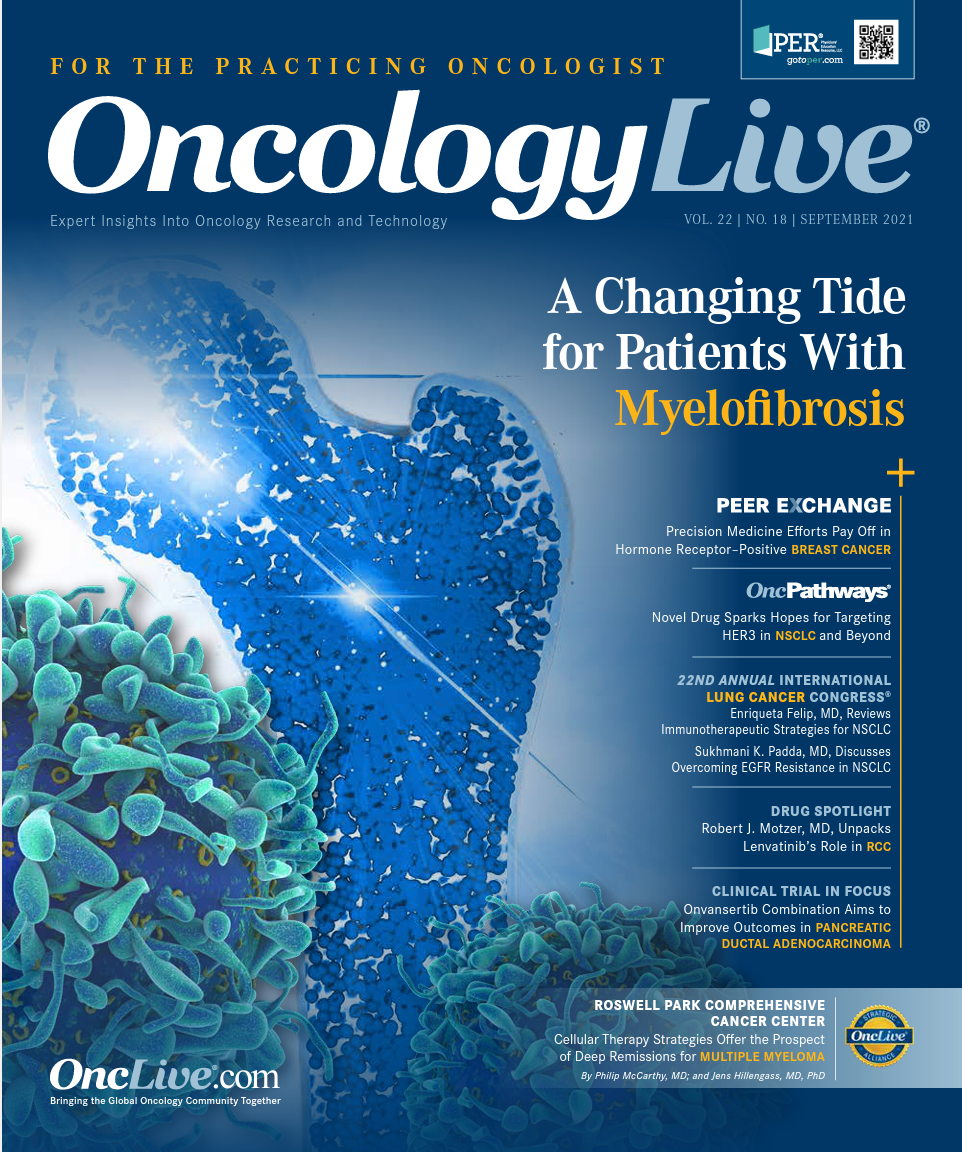
























%20(2)%201-Recovered-Recovered-Recovered-Recovered-Recovered-Recovered-Recovered-Recovered-Recovered-Recovered-Recovered-Recovered-Recovered-Recovered-Recovered-Recovered-Recovered.jpg?fit=crop&auto=format)
%20(2)%201-Recovered-Recovered-Recovered-Recovered-Recovered-Recovered-Recovered-Recovered-Recovered-Recovered-Recovered-Recovered-Recovered-Recovered-Recovered-Recovered-Recovered.jpg?fit=crop&auto=format)
